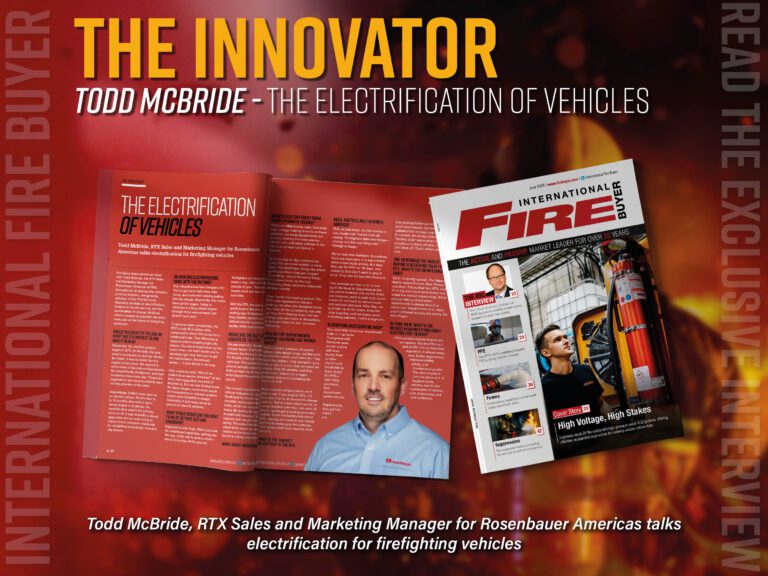Fire Buyer Managing Editor Rebecca Spayne investigates the changing foam proportioner landscape with expert Per Aredal, International Sales Director, Firemiks
Welcome to our Ask the Expert interview with distinguished foam specialist Per Aredal, the International Sales Director of Firemiks. Firemiks has been at the forefront of innovation in firefighting technology, particularly in the realm of foam proportioning systems. Per Aredal brings with him a wealth of knowledge and expertise in this field, making him the perfect person to discuss some of the most pressing issues and advancements in firefighting foams.
The article will delve deep into the intricacies of accurate foam proportioning, especially considering the different viscosities of firefighting foams. This is a crucial aspect of firefighting, as the effectiveness of pumps and foam in suppressing fires heavily relies on its accurate mixture and application.
A significant part of our discussion will also revolve around the transition from Aqueous Film Forming Foam (AFFF) to Synthetic Fluorine-Free Foam (SFFF). This shift marks a pivotal change in firefighting practices, driven by environmental concerns and the need for more sustainable and safer firefighting solutions.
Please could you give an overview of who you are and the history and heritage behind Firemiks?
Originally founded in 1979 as a Swedish family-based business – Firemiks AB is operated by the third generation, together with strong industrial partners. Throughout the years, our focus has been to develop, manufacture and distribute our own line of water driven pump proportioning systems worldwide. Our work method is to have the possibility to produce custom solutions to the individual needs of each client project, while also delivering regular models in accordance with international standards.
Can you explain how FIREMIKS foam proportioners work, especially in terms of adjusting to different foam viscosities?
The proportioning of the FIREMIKS is based on the principle of positive displacement for both the water motor that is driven by the extinguishing water flow and the concentrate pump that is driven by the water motor and which injects the concentrate into the extinguishing water flow. In this manner, the dosing relation is established by the volumetric relation of the water motor and the concentrate pump. This dosing relation is not affected much by viscosity, up to a limit of course as is detailed in the units’ performance data. The concentrate pump is connected to an atmospheric concentrate tank with gravity feed to the dosing pump. Solely the extinguishing water is required to power the whole dosing system.
What are the technological innovations in FIREMIKS systems that accommodate the varying viscosities of firefighting foams?
The volumetric water motor design was conceived by us in the late seventies, and it is very compact for the flow it can take. On a typical 3% unit, the water motor will take roughly 30x the volume of the concentrate pump, yet it is barely bigger. Since the start we have constantly refined its design for better performance and reliability. Like all pump design, it is all about the details and the execution. It is important to have flexibility to adapt the design and sizing, so we can quickly match the water motor up correctly with a wide variety of concentrate pumps, each of which also has its specifics to take into account.
Is it difficult to ensure accurate foam proportioning across a range of different viscosities?
As long as one follows the specified min and max flow of the data sheet, FIREMIKS accommodates changes in viscosity in a wide flow- and pressure range. There is no need for pressure balancing or calibration, nor is it possible without physically changing the unit.
What challenges does FIREMIKS, and the wider industry, face when transitioning from AFFF to SFFF in terms of viscosity handling?
Regulatory bodies are driving the shift from PFAS-containing concentrates to SFFF concentrates, prompting a reassessment of many proportioning systems for compatibility. Various manufacturers offer SFFF foams with a wide range of viscosities, including very high-viscosity concentrates. To select an appropriate proportioner, understanding the concentrate’s properties — whether it falls within a viscosity range of 1cP to around 5-6000 cP (measured using a Brookfield Viscometer Spindle #4 at 30 rpm) — or if it’s classified as very high viscosity is crucial. In the past engineers have relied on being to calculate the flow of concentrate, but with these new SFFF that are often non-Newtonian in their nature, accurately and reliably calculating the flow behavior is much harder. On devices that need calibration, the dosing might work in a specific set of circumstances, but as soon as one variable changes, it could fall out of calibration. Then it is much better to rely on a system that by design can accommodate a wide viscosity range, like FIREMIKS.
In what ways does the design of FIREMIKS proportioners, such as piston and gear pumps, cater to different foam viscosities?
FIREMIKS stands out by offering two types of dosing pumps — Piston and Gear pumps —alongside a robust multi-vane motor based on over 30 years of market experience. When working with clients, apart from considering flows and pressures, we prioritise understanding the concentrate type and viscosity, a quite complicated subject, before recommending the suitable pump type and accompanying installation advice.
Our models equipped with Piston pumps are classified as “Variable viscosity proportioners” in FM approval terminology. They maintain precise dosing rates within approved tolerances across a broad viscosity spectrum, from low viscosity to around 5-6000 cP (dependent on variables like temperature, concentrate type, and brand). Important to know is that all Piston pumps systems on the market have a limit upwards on handling viscosity concentrates, due to the Piston pump reciprocating principle; for each revolution, the plunger sucks concentrate and then presses it out and the concentrate goes from zero to full speed twice per revolution. If the static viscosity is too high with non-Newtonian concentrates, the concentrate might not flow smoothly and therefore the correct dosing rate may not be achieved…
To read the full exclusive article and other latest news, see our last issue here.
Never miss a story… Follow us on:
International Fire Buyer
@Firebuyer
Fire Buyer
Media Contact
Rebecca Spayne Managing Editor, International Fire Buyer
Tel: +44 (0) 1622 823 920
Email: [email protected]








































